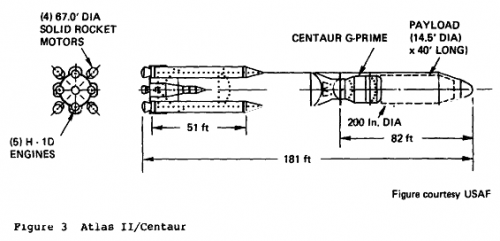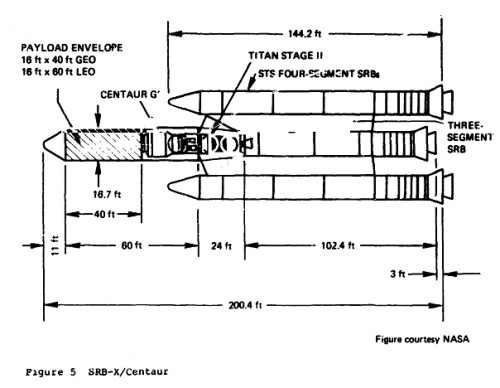- Joined
- 5 May 2007
- Messages
- 1,483
- Reaction score
- 2,860
Some competitors to the Titan 34D7, which became the Titan IV, from the 1984 report 'Assessment of Candidate Expendable Launch Vehicles for Large Payloads'. I've not bothered copying the details of the Titan 34D7 as its' ultimate form is quite well known.
Source:
http://hdl.handle.net/2060/1985015556
Atlas II
Performance: 11,000 lbs to GEO from 80 x 104 nautical mile orbit
It's not obvious to me where the 67" SRMs were proven from - the diameter is similar to a Minuteman, but the first stage on that rocket is only about half the length of the Atlas II SRM. Heck, the SRMs are almost as large as an entire Minuteman.
SRB-X
Performance: 11,500 lbs to GEO from 100 nautical mile circular orbit
I've seen this described as the 'single worst Shuttle-derived launch vehicle ever designed' which seems a bit strong, until you see what they had in mind for the thing. Yikes.
Source:
http://hdl.handle.net/2060/1985015556
Atlas II
The Atlas II/Centaur represents a redesign of the Atlas G. Its diameter is increased from 120 inches for the current Atlas to 200 inches. The Centaur G', which is being developed for the STS, will be used for the upper stage. The Atlas II propulsion system consists of 5 liquid rocket engines and 4 strap-on solid rocket motors, all of which use existing designs. The general concept for the Atlas II suggests that established technology and proven hardware will be used. The liquid rocket engines being considered for use are of proven lineage; their development was initiated over 30 years ago. Nevertheless, the Atlas II is structurally a new launch vehicle with corresponding risks.
Performance: 11,000 lbs to GEO from 80 x 104 nautical mile orbit
It's not obvious to me where the 67" SRMs were proven from - the diameter is similar to a Minuteman, but the first stage on that rocket is only about half the length of the Atlas II SRM. Heck, the SRMs are almost as large as an entire Minuteman.
SRB-X
The SRB-X launch vehicle system is also an assemblage of rockets Developed in other vehicles and proven in many successful flights. The first stage consists of 2 four-segment solid rockets identical with the first stage of the shuttle. The second stage is a three-segment variation of the first solid stage with a modification to the burning rate of the rocket fuel. The third stage is essentially an unmodified version of a standard Titan second stage. The upper (fourth) stage is a Centaur rocket identical to the one under development for the shuttle. However, because the first-stage Solid Rocket Boosters have been spaced to utilize STS launch facilities, development of a truss will be required making the SRB-X, like the Atlas II, essentially a new launch vehicle with some corresponding risks.
Performance: 11,500 lbs to GEO from 100 nautical mile circular orbit
I've seen this described as the 'single worst Shuttle-derived launch vehicle ever designed' which seems a bit strong, until you see what they had in mind for the thing. Yikes.


